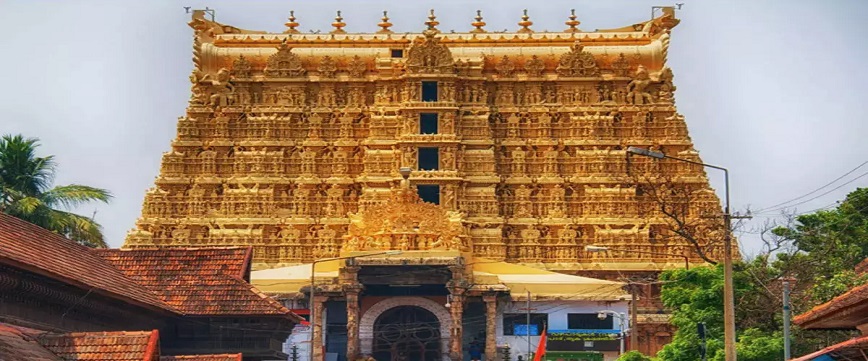
In Thiruvananthapuram, Kerala, the Sree Anantha Padmanabhaswamy Temple is a prestigious Hindu temple dedicated to Lord Anantha, an avatar of Lord Vishnu.
In the main shrine of the temple, an 18-foot idol of the principal deity lies on Adi Shesha, in the Ananthasayanam posture, in a temple built in Kerala style and Dravidian style.
Padmanabhaswamy Temple is among the 108 holy temples of Lord Vishnu, and it is one of the wealthiest temples in the world. It is famous for its hidden treasures.
According to popular belief, the temple was founded about 5000 years ago.
Divakara Muni Vilwamangalam founded the temple, according to palm leaf records. During his lifetime, he performed rituals at Padmanabhaswamy Temple Kasaragod, also known as Ananthapura Lake Temple. The temple is considered to be the original seat (moolasthanam) of Anantha Padmanabhaswamy.
As per the legends, Lord Vishnu appeared before sage Vilwamangalam as an orphan kid. The sage felt pity for the child and permitted him to stay at the temple. He helped him with the temple's daily activities. One day, Vilwamangalam punished the child harshly, so he fled to the forest.
It didn't take Vilwamangalam long to realize that the boy was Lord Vishnu himself. He then went in search of him. He followed him into a cave that led to the present-day city of Thiruvananthapuram. The boy disappeared into a mahua tree. As the tree fell, Lord Vishnu lay on the thousand-hooded serpent Adi Shesha.
The size of Lord Vishnu in this Ananthasayanam posture extended up to 8 miles, and sage Vilwamangalam requested him to condense to a smaller size. Lord shrank, but still, the sage couldn't see him completely. He could only see Lord Anantha in three parts due to trees blocking his view - his face, stomach and feet.
As the sage saw the Lord, the doors of Shri Padmanabhaswamy Temple in Trivandrum (Thiruvananthapuram) depict the large idol.
The earliest mention of the temple dates back to the 9th century, although its exact construction date is unknown.
According to palm leaf records, the roof of the sanctum sanctorum was repaired in the 15th century. It was around the same time that the Ottakkal Mandapam was constructed in the premises. Anizham Thirunal Marthanda Varma ordered renovations in the temple around the middle of the 17th century.
A statue made from 12,008 shaligram stones and various herbs, collectively called katu-sharkara, was installed in the sanctum sanctorum in 1739. In addition to the statue, the king built a stone corridor, a gate, and a flagstaff.
In 1750, he dedicated his kingdom to the Lord in the Thrippadi Danam ceremony.
Karthika Mandapam was built by king Karthika Thirunal Rama Varma in 1758. The Anantha Shyana mural was drawn by queen Gowri Parvathi Bayi in 1820.
The Kshethra Praveshan Vilambram (or Temple Entry Proclamation) of 1936 marked another major event in the history of Sree Padmanabhaswamy Temple.
Visiting Padmanabhaswamy Temple opens at 3 AM, and it remains open until late evening. You can't take blessings out of darshan slots, and you must adhere to the temple's dress code.
In the morning, you can get the darshan between 3.15 AM and 4.15 AM. After that, you can get the darshan between 6.30 AM and 7 AM, between 8.30 AM and 10 AM, and between 10.30 AM and 11.10 AM. The final morning darshan slot is from 11.45 AM to 12 PM.
Padmanabhaswamy Temple offers evening darshan from 5 pm to 6.15 pm and 6.45 pm to 7.20 pm.
Padmanabhaswamy Temple's dress code mandates that men wear mundus/dhotis around the lower half of their body. To match the dress code, you can wear a dhoti/mundu around your pants or shorts. Your upper body can be left bare or covered with a shawl known as angavastram. Boys must follow the same dress code as men.
It is permissible for women to wear sarees, dhotis, pavadas and blouses to the temple. You can also wear a T-shirt with a lehenga/skirt and wrap a dhoti over jeans/salwar suits to follow the dress code.
It is free to enter the temple, stand in the darshan queue, and wait for the darshan of the Lord. As time passes, the queue may get long. At the counter, you can buy special Padmanabhaswamy Temple darshan tickets if you wish to skip the long wait.
Padmanabhaswamy Temple VIP darshan costs 150 or 180 rupees (with prasad). The entry for two is 250 rupees along with a pooja thali. Kids enter for free.
You can also participate in a variety of special pooja rituals by booking in advance at the temple. There are three packages available: Nirmalyam to Deeparadhana (3.30 AM to 4.45 AM), Nirmalyam to Usha Pooja (3.30 AM to 5.30 AM), and Nirmalyam to Pantheeradi Pooja (3.30 AM to 6 AM). Nirmalyam to Ucha Pooja can be booked for 12,000 rupees.
Offerings such as Aravana, Payasam, and Unniyappam can also be purchased here and offered to Sree Padmanabha Swamy, Sree Narsimha Swamy, and Sree Krishna Swamy.
Padmanabhaswamy Temple is best visited during winter, from October to February, when the temperature remains pleasant to spend a few hours at the temple complex during the summer and monsoon months.
During those months, many important festivals are celebrated, and you can witness their grandeur.
For Lord Padmanabha darshan, you should go to Nirmalya Darshanam early in the morning. There aren't a lot of people at this hour, and you will feel the spiritual vibes during the pooja. You can join the darshan queue around 3 AM and watch the temple's special rituals.
Find here the detailed information about the religious places and temples in India.
Check out for the ultimate source of information on Indian temples and spiritual destinations. Click here to know more about Kalkaji Mandir in New Delhi History, Timings, Live Darshan & Golden Temple in Amritsar History, Timings, Facts, Architecture .
For more information visit: Sree Padmanabhaswamy Temple